Miaoshan was her name: daughter of Miaozhuang; Princess of Zinglin, ‘The Raised Forest Kingdom’ in the far west. She was the youngest of three daughters. Without a male heir to continue the kingdom’s legacy, Miaoshan and her two sisters were forced into odious marriages by their father, king Miaozhuang. But unlike her sisters, Miaoshan was pure and, in her own way, stubborn. She believed that it was her life destiny to cultivate her spiritual essence and escape Samsara, the endless cycle of rebirth and suffering.
Unable to convince Miaoshan and further exasperated by her disobedience, King Miaozhuang eventually sent his contumacious daughter to be executed. Not long after, the king fell ill with a strange ailment. No physician in the kingdom or medicine from far off land could alleviate his malady. But a sagacious monk eventually appeared to the king; he apprised that the peculiar infirmity could only be mended by drinking an elixir made from the arm and eye of ‘one without anger.' The monk also informed the king of a hermit residing on Incense Mountain who was willing to make all the necessary donations.
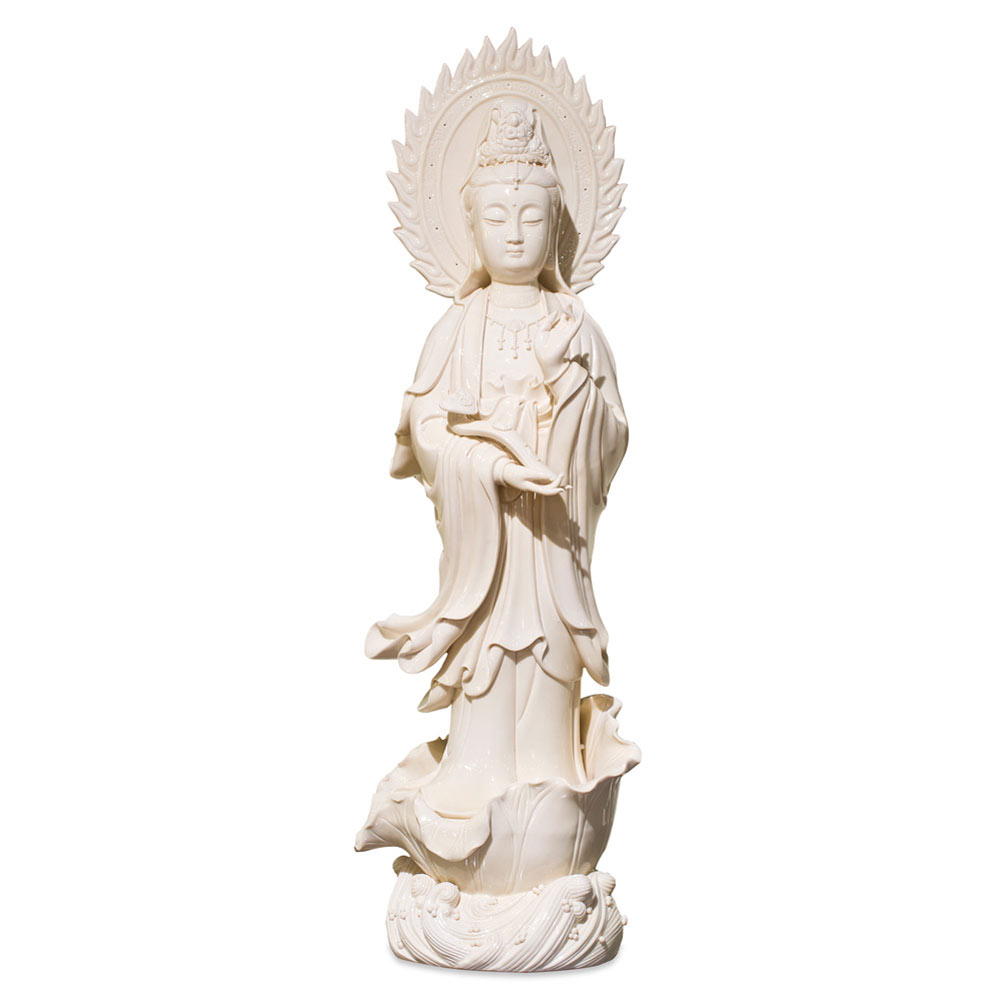
Chinese porcelain statue depicting Kuan Yin as a beautiful young woman in white robe, with an Amitabha headdress and fiery halo, standing on a floating lotus flower
The bizarre prescription was concocted; its effectiveness was instantaneous, and the king was promptly healed. Wanting to give thanks to his savior, the king made a pilgrimage to Incense Mountain. And to the king’s surprise, his savior was none other than Miaoshan, his daughter who had been miraculously saved from execution and was living a pious life atop the sacred mountain. The king fell before the maimed body of his daughter with penitence and begged for forgiveness. As tears were exchanged between father and daughter, Miaoshan transformed into a beautiful woman, robed in white, with one thousand arms and one thousand eyes. Miaoshan had obtained her enlightenment and escaped Samsara.
As she was about to enter the Pure Land Paradise, the Buddhism Heavenly Realm, Miaoshan heard a cry of anguish reverberating up from the world below. She looked around and saw a world filled with unbounded misery. Miaoshan could feel the gravity of a thousand worlds: each cry carrying countless lifetimes of sorrow. Miaoshan, now as the Thousand Armed Kuan Yin, turned her back to Heaven and took a vow of never leaving the Earth until all suffering has ended.
This small anecdote from The Precious Scroll of Incense Mountain or Xiangshan Baojuan (香山寶卷), with its earliest script dated to 1103, is one of the innumerable tales recounting the origin of Kuan Yin. The parable tells of the universal and humanistic struggles between the traditional familial bond and personal spiritual pursuit, the eternal love as well as the conflict between the father and daughter, while touching on the ubiquitous ideals of grace, mercy, and compassion. Consequently, Kuan Yin and the ideals she personifies continue to captivate the hearts and minds of countless Buddhist devotees and has become one of the most popular iconographies in Buddhism.
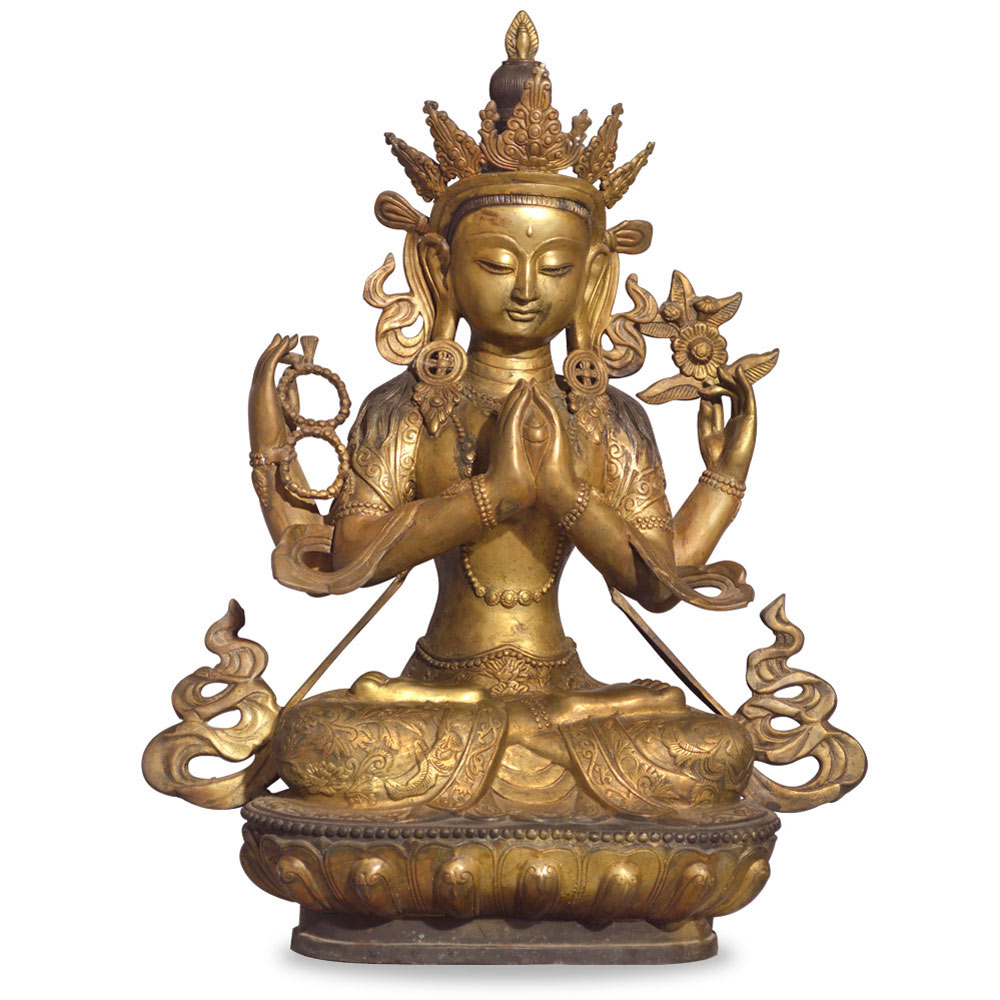
Bronze Tibetan statue depicting multi-armed Bodhisattva sitting in a lotus position
General History and the Various Interpretations of Kuan Yin
Although the tale from The Precious Scroll of Incense Mountain and popular interpretations depict her as a beautiful young woman robed in white, this was not the original depiction of Kuan Yin. According to the Lotus Sutra, the sacred second century Buddhist scripture, Kuan Yin was a handsome and princely Bodhisattva named Avalokitesvara. A Bodhisattva is not a god or a goddess. Neither is a bodhisattva a Buddha, but rather a Buddha-to-be, an earthly manifestation of the self-born and eternal Buddha Amitabha. According to Buddhist traditions, anyone who exhibits a Buddha-like quality, such as morality, self-sacrifice, and wisdom, has within themselves the ability to become a Buddha. The term Bodhisattva was first used to refer to Buddha Shakyamuni in his former lives. Because Buddhism also believes the world consists of infinite cycles of rebirth, anyone who is on the path to Buddhahood is considered a Bodhisattva. As such, the world inheres limitless Bodhisattvas, and these Bodhisattvas are functionally equivalent of the Buddha in their wisdom, compassion, and power.
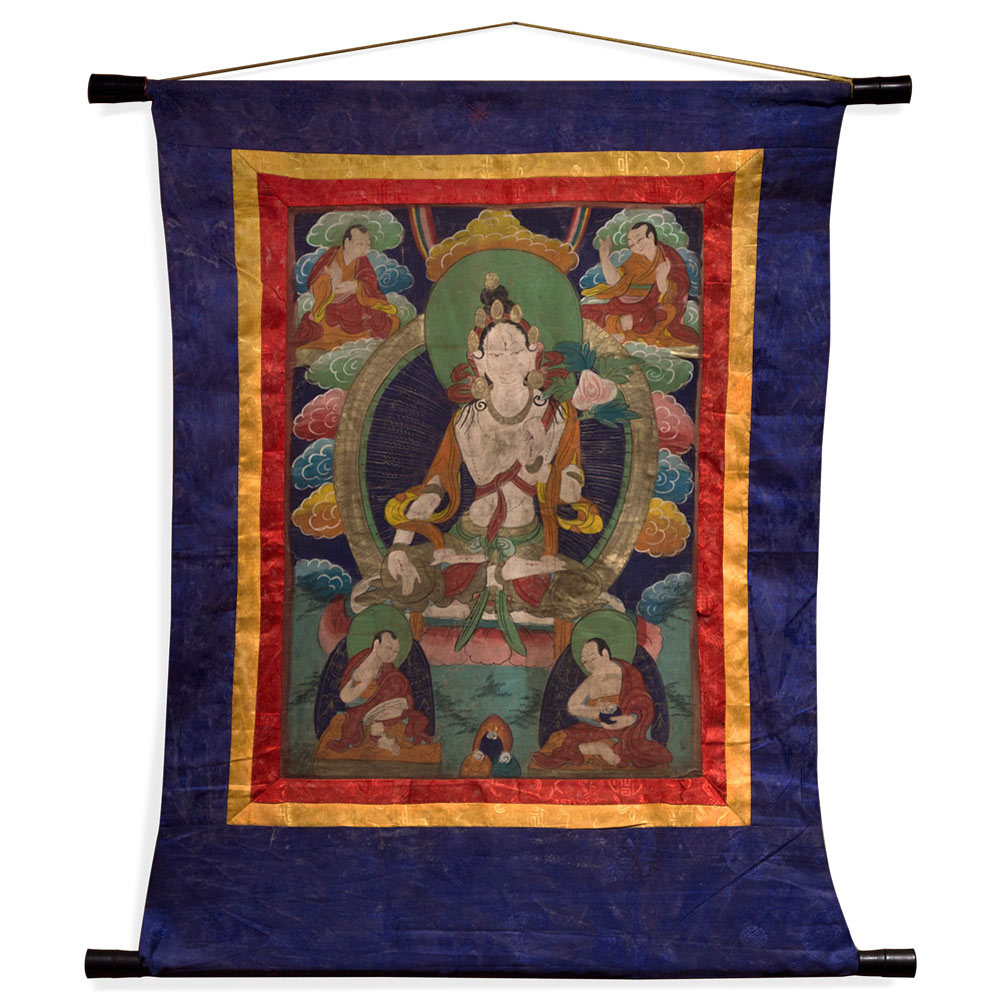
Tibetan Thangka Tapestry depicting a seated male Bodhisattva surrounded by devotees. The painting portrays the Bodhisattva with feminine form, robed in royal Indian attire, a contrast to the simple monk robes being worn by his followers.
Although all Bodhisattvas are compassionate and merciful, Kuan Yin is considered to be the embodiment of these abstract principles. The original name of Avalokitesvara means “Lord who Looks Down” in Sanskrit, while Kuan Yin, or Guanyin, in Chinese means “the Perceiver of the Sounds of the World.” In the Lotus Sutra, Kuan Yin protects the world in the time between the departure of the historical Buddha, Siddhartha Gautama or Shakyamuni, and the appearance of the future Buddha, Maitreya. The sutra detailed Kuan Yin’s miraculous deeds, such as freeing people from lust, hatred, and ignorance, and granting children to infertile women. In order to achieve her goals, Guanyin has the ability to assume any form, male or female, human or non-human, adult or child, is required to teach Dharma, the way of the Buddha, and to relieve suffering.
Kuan Yin's nebulous form and power suggest that the Bodhisattva is androgynous, without gender, or gender-neutral. When Buddhism first emerged from India, Kuan Yin's statues and paintings depicted him as a young male Bodhisattva with feminine curves, wearing a chest-revealing Indian robe and princely jewelry. His feminine form is often contrasted with a light mustache. He is identifiable from other Bodhisattvas through his distinctive headdress: a jeweled crown with an image of a seated Amitabha with emanating rays of light that represent his infinite wisdom.
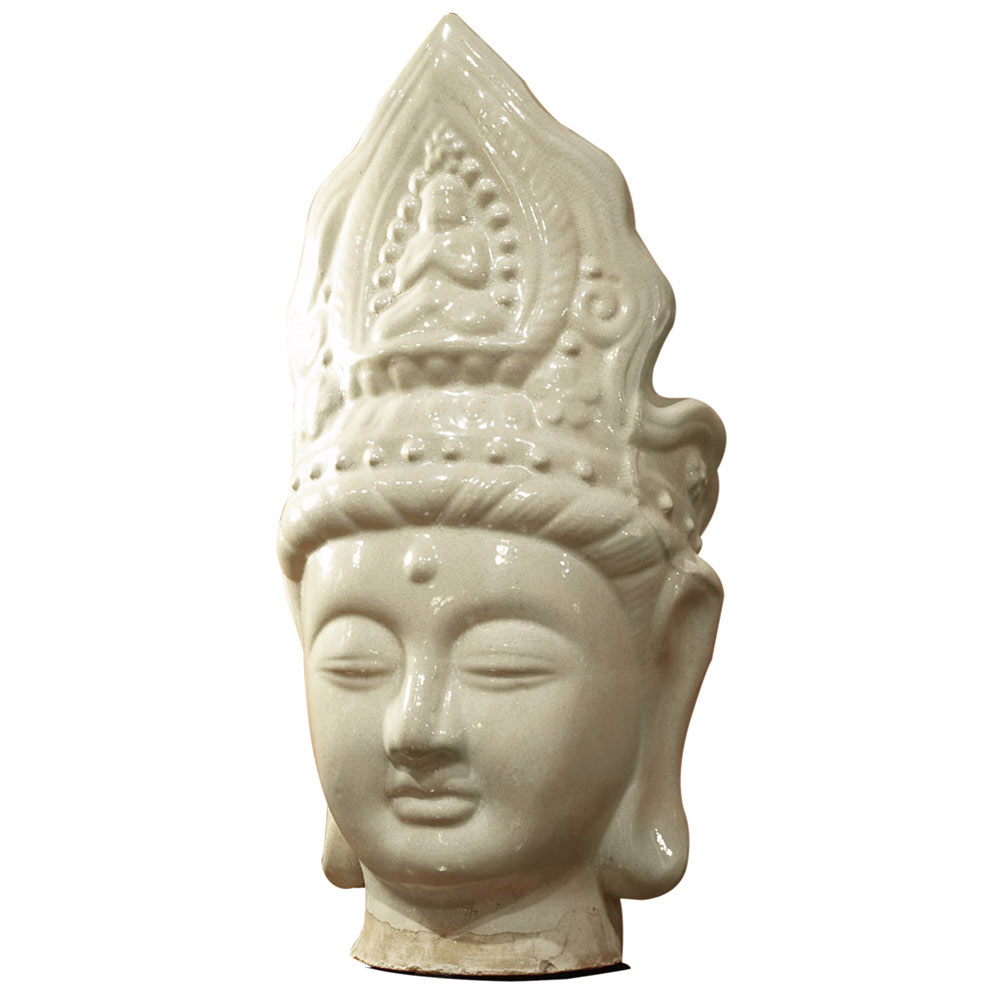
Ceramic statue of Kuan Yin head, identifiable by her elaborate headdress with an image of a sitting Amitabha
As Buddhism slowly spread across China, the original depiction of Kuan Yin began to adopt local customs. Tang Dynasty Buddhism popularized the image of the Thousand-Armed Kuan Yin, which symbolizes his omnipresent power and readiness to aid anyone who is in distress. It is worth noting that the term ‘one thousand’ in Chinese culture represents infinitude. In martial arts, one who practiced a strike a thousand times has mastered the strike in all of its forms. In scholastic disciplines, a person who knows a thousand things does not literally know only a thousand facts but is one who is wise enough and has studied enough to know everything. Hence, the thousand-armed Kuan Yin with a thousand eyes represents an entity who can reach out to everyone, having the ability to see and hear all prayers.
From the Song Dynasty in the tenth century onward, Kuan Yin representations began to transition toward the female form. Scholars believe that this change was due to the adoption of local religions and the incorporation of regional goddesses into Buddhism religious practices. In the Fujian region, for example, the prevalent depiction of Kuan Yin is as a young maiden dressed in Tang Hanfu carrying a fish basket, acting as the custodian of the local fishermen. However, the most accepted representation of Kuan Yin in China remains the image of a young woman wearing a flowing white robe with necklaces of Indian or Chinese royalty and a crown depicting the Amitabha Buddha.
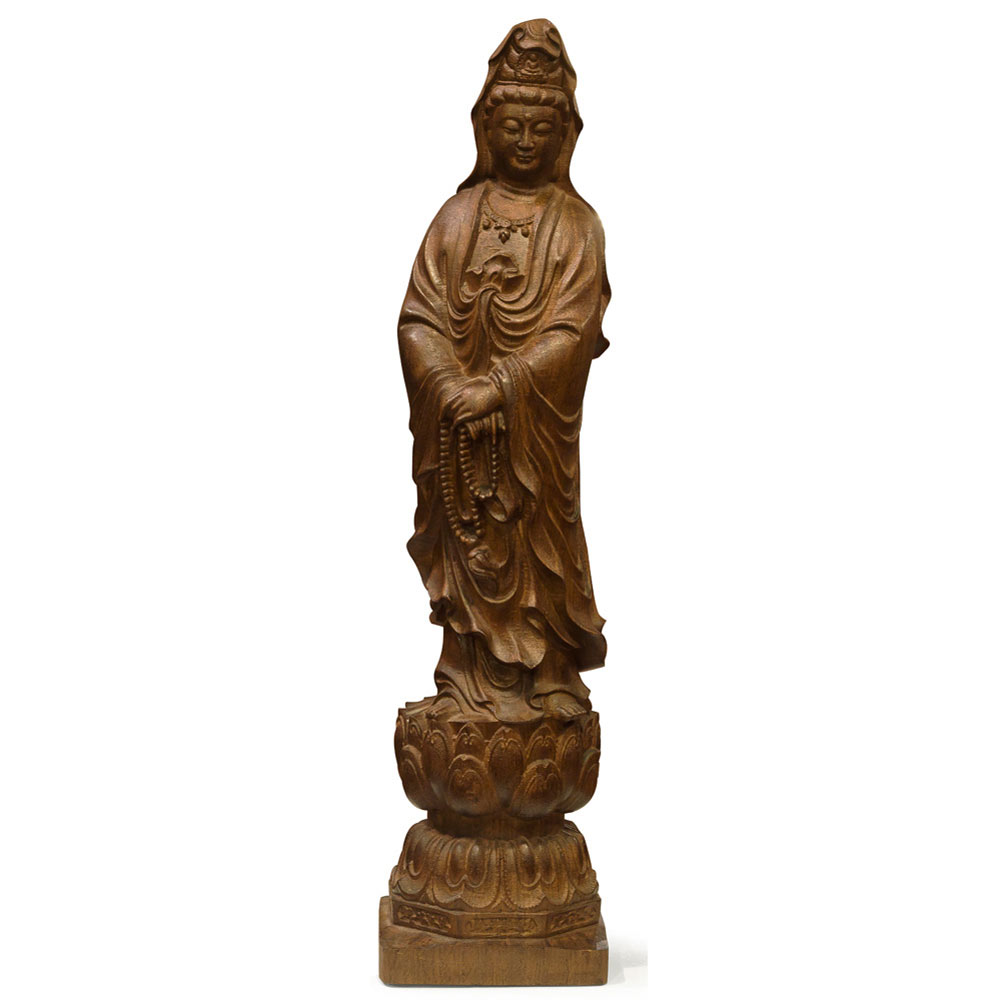
Wooden Chinese Kwan Yin statue depicting a standing Kwan Yin, likely after Late Song Dynasty interpretation
Water Infinity and Symbolism
In addition to the feminization of Kuan Yin, local mythologies and religious symbols also began to appear in Kuan Yin statues and paintings. Artistic depictions of Kuan Yin often depicted her standing atop a dragon or a lotus flower, holding various water symbolic elements like a weeping willow branch, a jar of pure water or a lotus flower. The vase of pure water, often in the left hand, sometimes shown pouring water, is one of the Eight Symbols of Good Fortune in Chinese culture. The vase contains pure water capable of relieving suffering and sickness. The willow branch, frequently in the right hand, accompanying the vase of water, is used to sprinkle divine water. Willows hold significant meaning as they are often found by pond or lake, and are capable of bending without breaking.
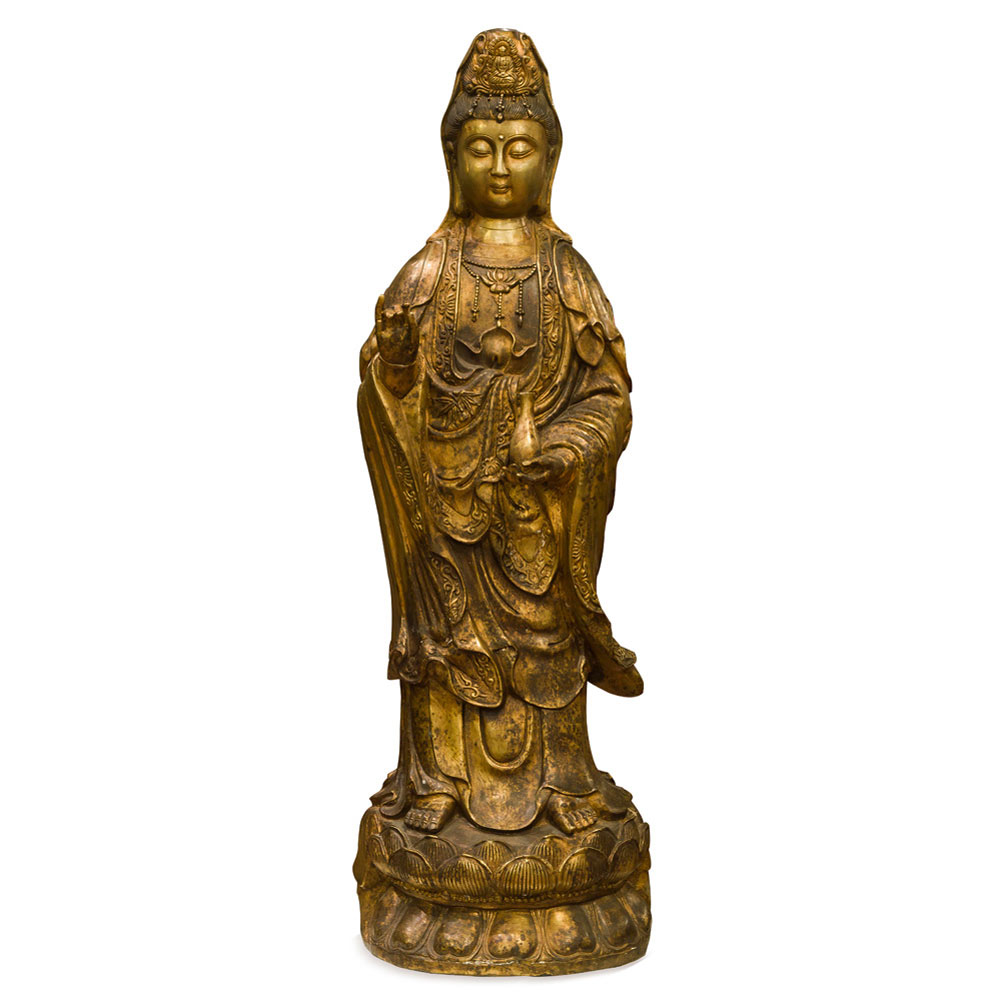
Bronze Chinese Kuan Yin statue. A female Kuan Yin atop a floating lotus flower, with a vase of pure water on the left hand
The Lotus blossom is a common symbol of purity in the Buddhist religion. The lotus flower, although beautiful, began its life in the dark and muddy sediment of the pond. Human beings are identical: life starts in the darkness of ignorance, but through Dharma, or the way of the Buddha, thrive away from the dark and toward the light. Kuan Yin, Bodhisattvas, and Buddha are therefore often shown standing or seated on a large lotus flower floating above the water, signifying their achieved enlightenment.
Kuan Yin is also sometimes depicted surrounded by dragons. Unlike Western cultures, which commonly associate dragons with the fire element, in Eastern traditions, the dragon symbolizes flowing energy, water, and Chi. Statues of Kuan Yin may show her being surrounded by a sea of dragons to represent her spiritual connection to water and establish her as the patronesses of fishermen.
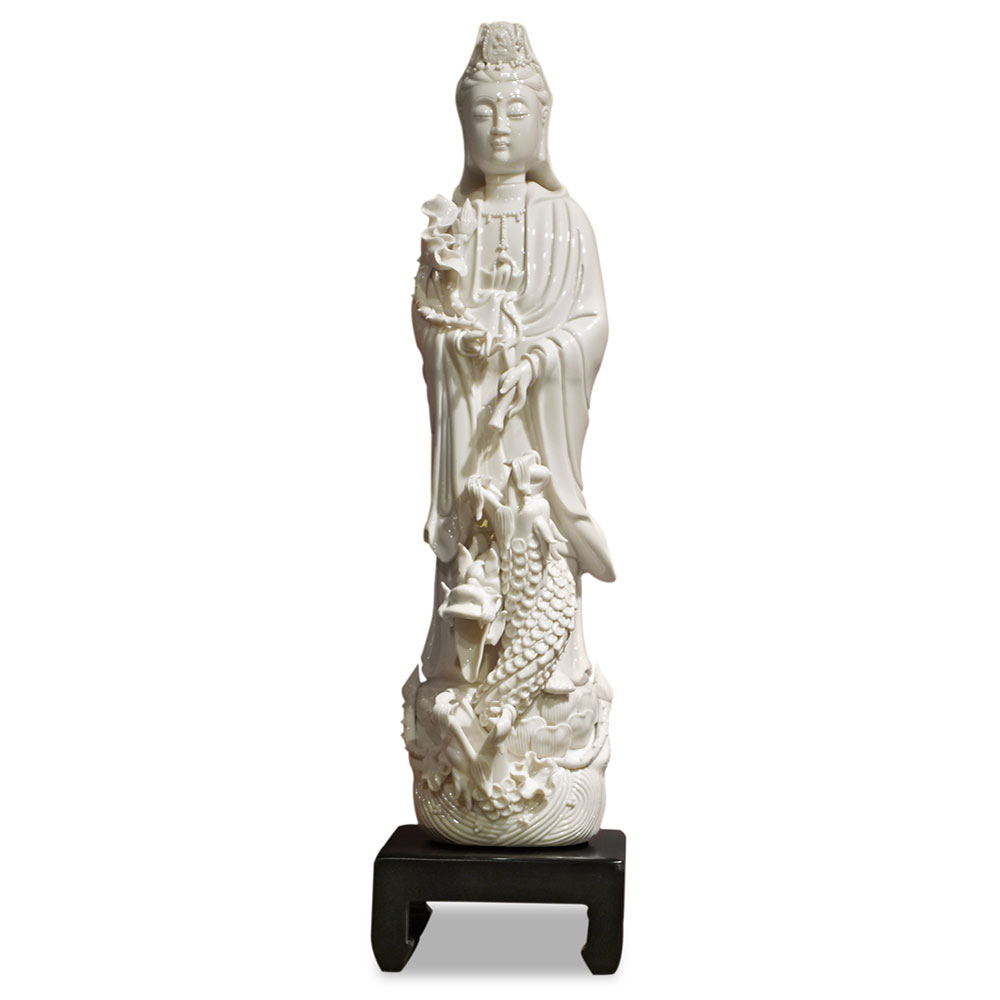
Porcelain Chinese Kuan Yin Drip Fountain Statue showing a female Kuan Yin surrounded a sea of swirling dragons. In her left hand is a vase of dripping pure water, while her right hand holding a blooming lotus blossom
The title of "Goddess of Mercy" was eventually bestowed upon Kuan Yin by Jesuit missionaries toward the late Imperial China era. Christian travelers saw the innate connection between Kuan Yin and their own Virgin Mary; understandably so. The universal ideal of compassion is often associated with femininity and motherhood. Kuan Yin, believed to have the power to grant children to infertile women, is sometimes depicted with a child or accompanied by two young children, Shancai and Longnu.
Tales of the Two Young Acolytes: Shancai and Longnu
According to the Complete Tale of Guanyin and the Southern Seas or Nánhǎi Guānyīn Quánzhuàn (南海觀音全撰), a novel from the Ming Dynasty, Shancai Tongzi, or Sudhana in Sanskrit, was a young disabled boy who was seeking enlightenment. Shancai, having heard that the Bodhisattva Kuan Yin was meditating on Mount Putuo, journeyed there to learn from her, despite his disability.
As the story goes, after the arduous journey, Shancai found Kuan Yin meditating by the jagged cliff of Mount Putuo. As he approached to profess his devotion, strange winds began to howl around him. Trees began to sway and creek; they twisted and groaned until devilish forms emerged from their disheveled boughs. Roots snapped into horrendous legs; leaves weaved into villous, sword brandishing arms. The trees on the mountain had transformed into ruffians and barreled toward Shancai and the meditating Bodhisattva.
As the ruffians closed in on Kuan Yin, Shancai looked in horror as the Bodhisattva leaped off the cliff in an attempt to escape her pursuers. Shancai, in his desperation but without hesitation, jumped off after his newly found teacher. But, as Shancai opened his eye, he found himself sitting beside Kuan Yin. The winds subsided, serenity returned, and the ruffians had faded back into the foliage afar. Kuan Yin lifted Shancai, and in amazement, Shancai also found that he could walk normally and is no longer crippled. Shancai had passed the test, and from that point onward, Kuan Yin took Shancai under her guidance as her acolyte.
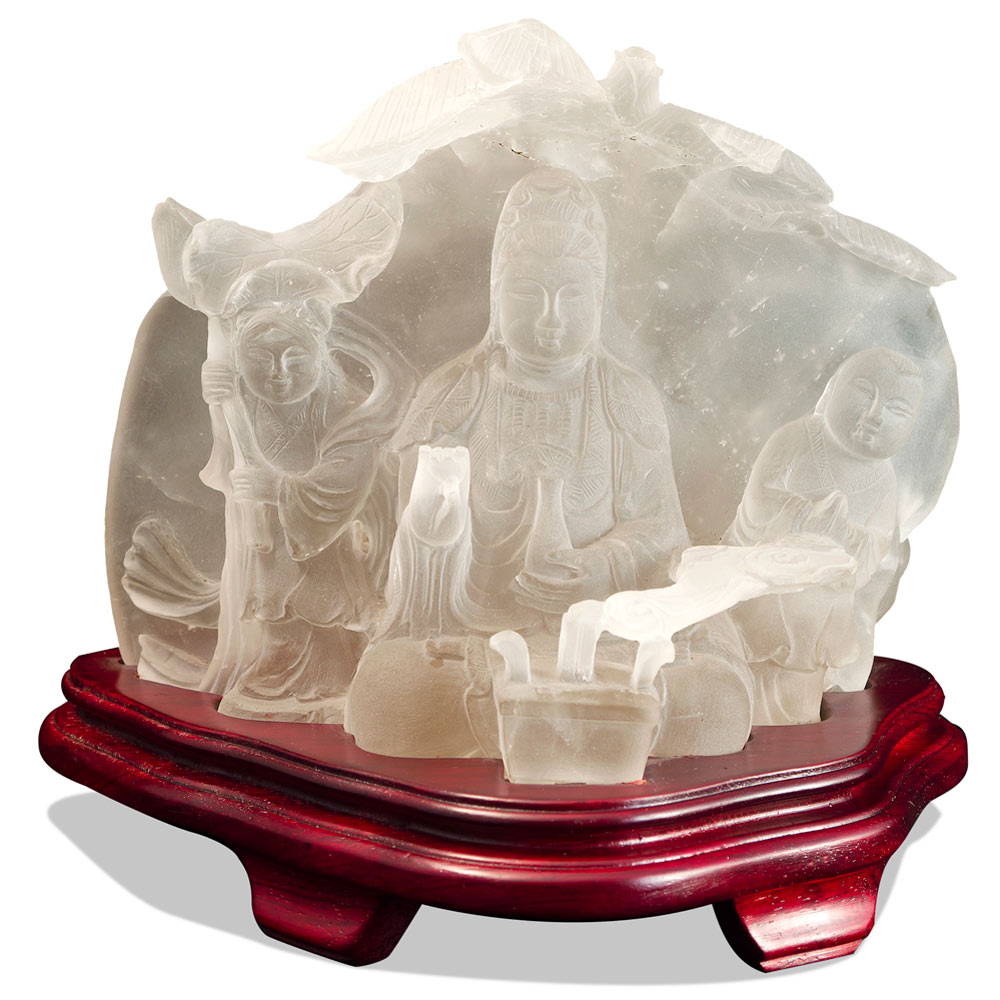
Small Frosted Quartz Sculpture of Kuan Yin with her two attendances, Shancai and Longnu, on the Incense Mountain
Longnu, on the other hand, was the granddaughter of the Dragon King of the Sea. According to the Complete Tale of Guanyin and the Southern Seas, the journey of Kuan Yin and Shancai eventually led them to a small coastal town by the sea, where a strange commotion was taking place in the local fish market. Noblemen and local villagers alike congregated around a table, on which lay a fish. Despite being out of the water for many days, the fish had not died. The peculiarity led the local folks to speculate that the fish had the magical power of longevity and would grant immortality if consumed. As word of the miraculous fish spread, an auction was arranged.
The fish cried out to Kuan Yin in its distress. Shancai, who wanted to save the ill-fated creature, collected all of his money. A futile attempt, as he was soon outbid by the noblemen. Shancai with no other option pleaded with the fishmonger to spare the fish’s life, but the potential buyers protested and forcefully snatched the fish away. Just as the fish was about to be killed, wind from the eastern sea began to pick up. And in the howling of the wind, Kuan Yin projected her voice to the crowd, saying: ‘A life belongs to the one who tries to save it and not the one who tries to take it.’ Shamed by their action, the bidders dispersed.
Rescued, the fish revealed to Shancai and Kuan Yin that he was the third son of the Dragon King. Being caught in the fishermen’s net in his fish form and brought on to dry land, the Prince lost all of his power and was unable to regain his dragon form. His father, being the dragon king of the sea, was also helpless in the situation. Wanting to show gratitude, the Dragon King sent his granddaughter, Longnu, to present Kuan Yin with the ‘Pearl of Light’, a precious pearl which constantly emitted light. Longnu, a wise child, immediately recognized Kuan Yin’s compassion and wisdom. She asked Kuan Yin to take her as a disciple and teach her the Dharma. Kuan Yin assented, but only if Longnu agreed to become the guardian of the ‘Pearl of Light.’
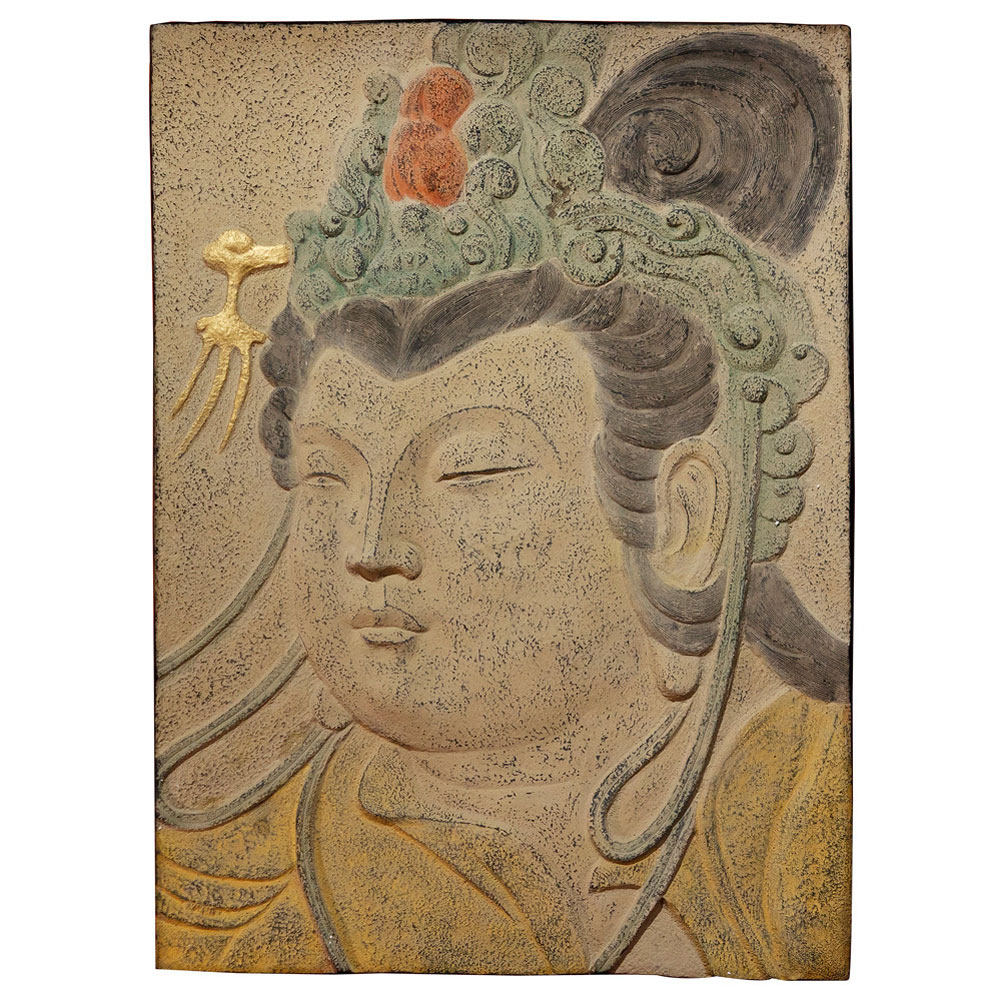
Chinese Wall Sculpture depicting the Dunhuang Mogao Cave interpretation of Kuan Yin from the Tang Dynasty. The yellow dress and the green crown with its golden hairpin are likely Tang royal attire.
From an Indian prince to a Chinese princess, from a daughter to a mother figure, Kuan Yin’s myriad forms and interpretations illustrate her innate ability to traverse across eras and cultures. With each iteration, her form adapts to the local custom and traditions in order to reach out to the people she is trying to help. Perhaps, it is true what was foretold in the Lotus Sutra: Kuan Yin is nebulous and she has the power to transcend across gender, class, and age in order to cultivate a world of compassion and mercy. This formlessness further speaks to the truth of her innate tie with water. Water heals. So does mercy. Like water, ceaselessly springing forth from the mountain top, and creeping between the cracks and crevasses of the earth, Kuan Yin’s compassion leaves no stone untouched. Like the summer rain that falls on the parched land, her mercy indiscriminately brings salvation to all it touches. Like the waves of the ocean tides, her wisdom eternally crashes upon the jagged shore of apathy. The collectiveness of compassion is the key to levitating the shared suffering. By having and exhibiting compassion for all fellow sentient beings, the way of the Buddha can be universally achieved.
References and Further Reading:
Britannica Editors (2018). Avalokiteshvara. Britannica Encyclopedia.
Lopez, Donald (2016). What Actually Happens in the Lotus Sutra? Lion’s Roar Website.
Monaghan, Patricia (2010). Goddesses in World Culture, Volume 1. Praeger.
University of Washington. Bodhisattvas.
Yu, Chun-fang (2001). Kuan-yin, The Chinese Transformation of Avalokitesvara. New York: Columbia University Press.


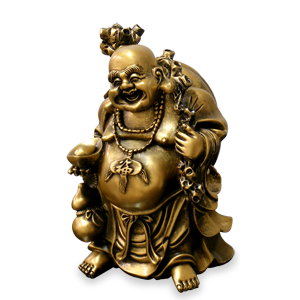
SocialMedia